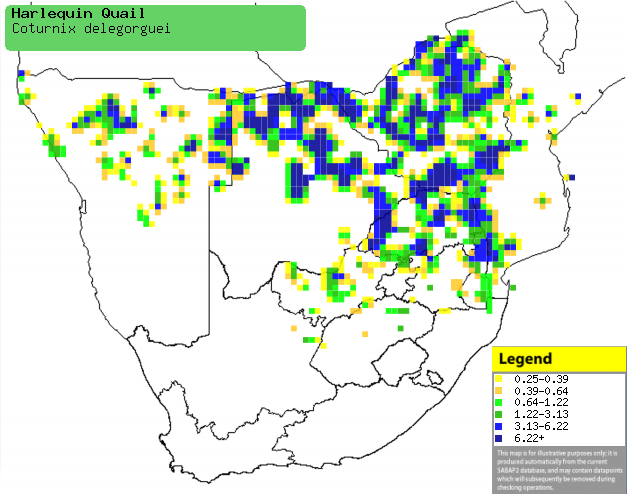|
Coturnix delegorguei (Harlequin quail)
Bontkwartel [Afrikaans]; isiGwaca (generic term for quail)
[Zulu]; Erurumbe (generic term for quail) [Kwangali]; Huta (generic name for
quail) [Shona]; Dzurhini, N'hwarixigwaqa, Xigwatla [Tsonga]; Tshosabannę
(generic term for quail) [Tswana]; Harlekijnkwartel [Dutch]; Caille arlequin
[French]; Harlekinwachtel [German]; Codorniz-arlequim [Portuguese]
Life
> Eukaryotes >
Opisthokonta
> Metazoa (animals) >
Bilateria >
Deuterostomia > Chordata >
Craniata > Vertebrata (vertebrates) > Gnathostomata (jawed
vertebrates) > Teleostomi (teleost fish) > Osteichthyes (bony fish) > Class:
Sarcopterygii (lobe-finned
fish) > Stegocephalia (terrestrial
vertebrates) > Tetrapoda
(four-legged vertebrates) > Reptiliomorpha > Amniota >
Reptilia (reptiles) >
Romeriida > Diapsida > Archosauromorpha > Archosauria >
Dinosauria
(dinosaurs) > Saurischia > Theropoda (bipedal predatory dinosaurs) >
Coelurosauria > Maniraptora > Aves
(birds) > Order: Galliformes
> Family: Phasianidae
Identification
Male at rest is easily distinguished from the
Blue and
Common quails by the chestnut and black underparts. It also differs from the
similarly dark-coloured male Blue quail in having a white eyebrow stripe. Female
looks similar to the female Common quail but has darker chestnut-coloured
underparts without a whitish coloured belly. It differs from the female Blue
quail in not having barred patterning on the underparts. Immature Harlequin and
Common quail are hard to distinguish.
Distribution and habitat
Widely distributed in savanna and woodland regions in
Africa; also occupying southern Arabia and Madagascar. Within southern Africa it occurs
in the North-West Province, Free State, Gauteng, Limpopo, Mpumalanga, northern KwaZulu-Natal,
Swaziland, northern Namibia, northern Botswana, Zimbabwe and Mozambique. It
generally favours savanna woodland with patches of bristle grasses (Setaria)
and Sorghum (Sorghum purpureosericum).
|
 |
|
Distribution of Harlequin quail in southern Africa,
based on statistical smoothing of the records from first SA Bird Atlas
Project (©
Animal Demography unit, University of
Cape Town; smoothing by Birgit Erni and Francesca Little). Colours range
from dark blue (most common) through to yellow (least common).
See here for the latest distribution
from the SABAP2. |
Call
Movements
Subject to large scale movements that are influenced by
rainfall. There is a pattern of movement within southern Africa with birds
moving south in the rainy season to breed. Migrate at night and are often killed
by flying into buildings or being killed on roads.
Food
Mainly eats invertebrates, doing most of its foraging
beneath cover, or occasionally on the edges of roads and tracks. The
following food items have been recorded in its diet:
- Invertebrates
- insects
- small snails and slugs (Molluscs)
- Plants
- seeds of grasses
- Eleusine
- Setaria
- Sorghum purpureosericum
- seeds of weeds
- green shoots
- leaves
Breeding
- Pairs breed in close proximity to one another, almost
forming a colony.
- Nest is made by the female and consists of a scrape in the
ground, sometimes lined with grass or leaves, hidden among the grass.
- Egg-laying season peaks after heavy
rains.
- After laying 4-8 eggs, the female incubates them for
14-18 days before they hatch. Up to 22 eggs can be found in a nest, the
result of laying by multiple females.
- Chicks are able to fly short distances after five
days.
References
-
Hockey PAR, Dean WRJ and Ryan PG (eds) 2005. Roberts
- Birds of southern Africa, VIIth ed. The Trustees of the John Voelcker
Bird Book Fund, Cape Town.
-
Sinclair, I, Hockey, P. and Tarboton, W. 2002. Sasol
Birds of Southern Africa. 3rd edition. Struik, Cape Town.
Text by Hamish Robertson |
